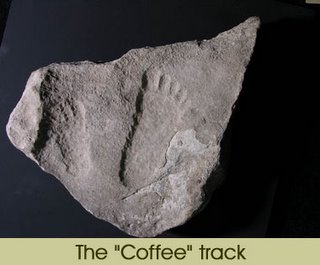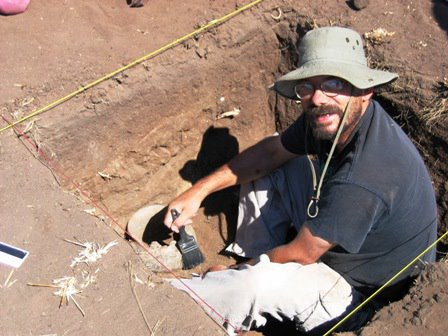
Carl Baugh is at it again, showcasing another set of human footprints that will be the smoking gun to make all of us evolutionists back down and admit that 150 years of scientific inquiry has been for naught. I have to admit, I have a special fondness for Carl Baugh, largely because he (and a couple of his advocates here in Lassen County) recently provided me an opportunity to publicly challenge his lack of scientific knowledge. But also because I have never seen someone spend so much time building so great a façade of professional expertise to cover such lack of a scientific background. At least Ken Ham is honest about his background (if not in the information he provides young children).
Carl has now prodded out the “Coffee” track, named after the discoverer of the print, Mr. A.M. Coffee of Stinnett, Texas. The slab of rock shows two human footprints, one adult and a child’s footprint and the rock itself is supposedly Permian in age (approximately 250 to almost 300 million years). In the words of the Creation Evidences Museum:
The discovery created an instant controversy among archaeologists, geologists and anthropologists, because the sedimentary rock system of the entire area is geologically assigned Permian (assumed to be 225 million years old).
Baugh got permission from the owner to subject the rock slab to a CT Scan. The “technical staff” conducting the scan apparently provided the following information (again, from the Creation Evidences Museum website):
With his gracious cooperation the track was submitted to a nondestructive Spiral CT Scan analysis at a laboratory. While the information was being processed through the computer, the technical staff immediately pointed to the screen and emphasized the compression areas under the track and between the toes. The staff also emphasized the clearly discernible five toes, the three arches (medial, lateral, and metatarsal), and the overall distinctive shape of the human foot.
The website contains further information and photographs but none adding additional information. As is usual with Baugh, I am left with far more questions than answers. For being a self-proclaimed degreed “expert” in the fields of archaeology and paleontology, he constantly fails to provide even the most basic descriptive data for any of his “discoveries”, and the Coffee track is no exception. I’ve seen archaeological site records for historic can scatters that contain more information than all of Baugh’s discoveries combined. So, what would the basic information requirements be for something like this? As a professional archaeologist with years of field and laboratory experience, here’s my advice to Baugh:
1) Provenience is the key. Without knowledge of precisely where the rock or artifact came from, the evidence is just that: another rock. Context is so basic to every argument that follows that we professional archaeologists spend inordinate amounts of time establishing it. (This is also why we get so annoyed when pot-hunters collect arrowheads and other artifacts from sites – the information value of the piece is lost and it becomes just another dust magnet for the mantle piece. This is also, incidentally, why laws are established to prohibit pot-hunting). So Carl needs to better establish the location of the slab – is it actually of Permian age? Of course, the original discoverer and several others removed the pieces from their original context, so precise location is unknown. The website implies that Baugh has a good idea where the slab came from, so that needs to be demonstrated empirically and not on a word-of-mouth basis. Yes, I know all the people involved were good Texas Christians who wouldn’t dream of breaking the 8th Commandment under any circumstances, but if Baugh wants to be taken seriously as a scientist, he’ll need to establish the location empirically. (Besides which, there are so many assumptions built into the previous sentence that I can’t even fathom a discussion at this point). Ok, so there’s no map. Are there analytical tests that can establish if the slab is, itself, Permian in age? How about establishing that the chemical composition of the slab is identical to the formation in the area of its location? I’m not up on all the current geological tests that can be done, but we do this to “source” obsidian and basalt all the time. Even failing that, where is the basic description of the slab’s mineral composition in comparison with that of other rocks in the discovery area? Are the rocks in the discovery area even Permian or do they include other period formations, including younger ones? Even if he’s lacking specific data to suggest precise location, Baugh needs to make an empirical argument that the footprint slab might conceivably come from the same area the original discoverer said it came from. Baugh notes the “thin crustal layer of sediment” overlaying the parent material and into which the footprints appear to be made. What is the geologic relationship between the footprint layer and the underlying rock? Is one derived from the other? Is the footprint layer geologically derived or is it artificial? Baugh needs to take time to address these if he wants to gain professional credibility.
2) Is it a footprint? Looks like a footprint to the untrained eye, but in all honesty to someone with a physical anthropology background, it doesn’t look like one to me. Despite what Baugh says on the website, the “footprints” lack the characteristics of true human footprints, including varying depth (to account for the arch of the foot – the Coffee track is completely flat) and no medial “instep” (also to account for the foot arch – the Coffee track shows a complete outline). In effect, the print looks too contrived to be made by a human during the course of daily moving about the landscape. (Next time you have mud in the yard, take a walk across it in bare feet and see if your prints look like the Coffee track). The CT Scan is technological fluff: it shows nothing of any anatomical value, including nothing that Baugh says it shows. Baugh needs to have professionals with the appropriate backgrounds look at the print to determine its consistency (or inconsistency) with modern human footprints. One can do this non-destructively by having casts made and set to a number of laboratories for further analysis.
3) Invite professionals in to take a look. The nature of science is that if your evidence says what you think it says, then others should be able to look at it and come up with the same conclusion. Where scientists don’t concur further study is done until one or the other idea gains additional support. In this way, science advances our knowledge. Hiding the data, limiting access, or not providing sufficient descriptions and photographs only leads to suppositions that the discoverer is hiding something. Who is the “technical staff” who did the CT scan? How did they come by their experiences? Who are the “archaeologists, geologists and anthropologists” who seemed to think these were a) footprints and b) encased in Permian rock? If Baugh really, really, really thinks he has Permian aged human footprints, he’ll go through every effort to allow others to look at and analyze the evidence.
Well, I certainly hope Baugh follows my advice, although I wouldn’t take that bet to Las Vegas. I really don’t think Baugh is interested in demonstrating his ideas scientifically. Like all creationists, he’s most concerned with presenting scientific sounding “evidence” (with all the really important information left out or conveniently “lost”) to scientifically illiterate audiences who are just looking for something to bolster what they already believe. This means peddling the creationist snake oil to small churches in small communities (like he did last year in Susanville). Additionally, Baugh is looking to impress these same folks with a self-promoted education, degree and experience that would appear to put him in the same league with the professional big boys. The problem is that like his “evidence”, the professional background turns out to be fake. He can’t play with the big boys because he doesn’t know how to swing the bat.
(After writing and posting this, I see that Glen Kuban has a draft analysis of the Coffee track already out. Some years ago, Glen demonstrated that Baugh's Paluxy River "man tracks" were erosional features and not true footprints at all. Glen also links to Laurie Godfrey's article on how to identify human tracks. Both are worth a read.)




5 comments:
Cool blog, interesting information... Keep it UP » » »
This cannot have effect in fact, that is what I believe.
I have one of these footprints. you may contact me at vjsweeney@cox.net if you have any up to date information
I have one of these footprints. you may contact me at vjsweeney@cox.net if you have any up to date information
Your refutation is funny. Looks like a sub-Saharan African footprint. Willingly ignorant. lol
Post a Comment